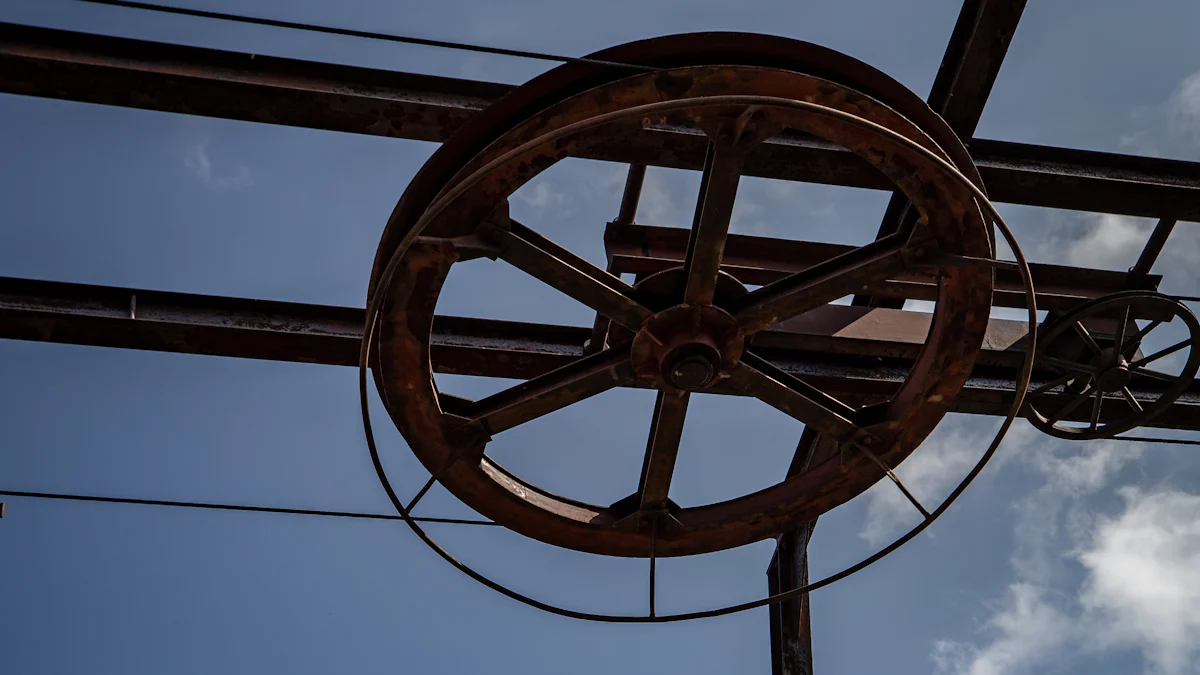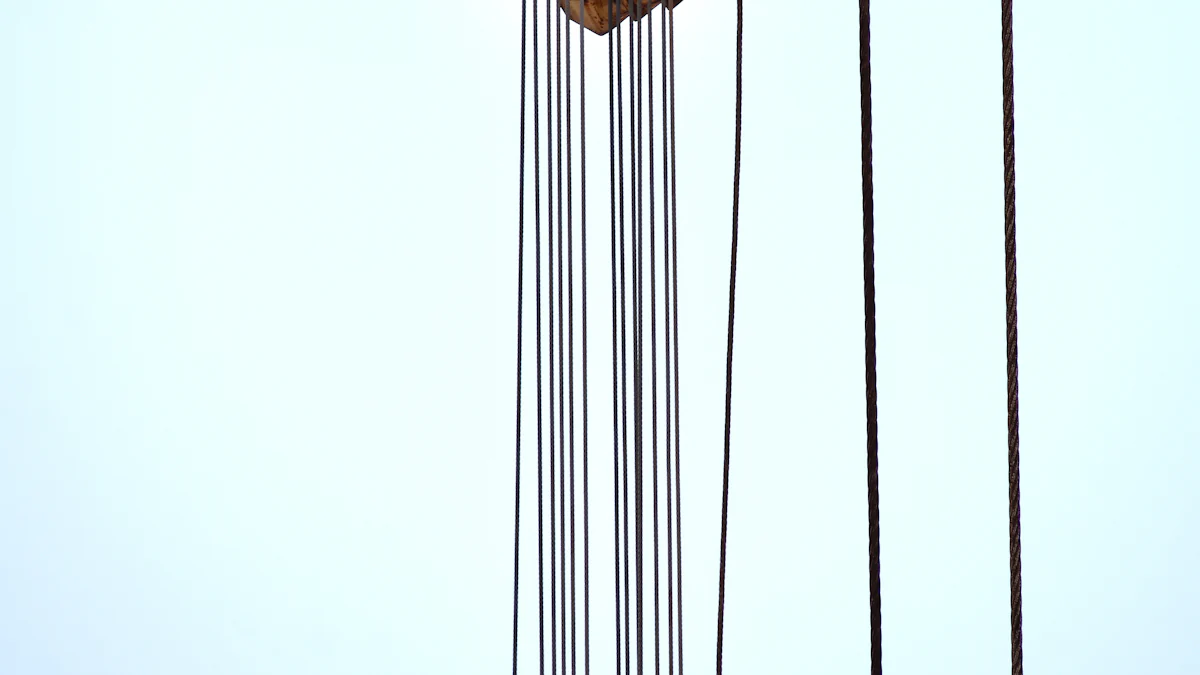Circular arc pulleys play a vital role in mechanical power transmission. You can think of them as specialized components designed to transfer energy efficiently between shafts using belts. Their unique curved design ensures a firm grip on the belt, reducing slippage and enhancing performance. This design allows you to achieve smooth and reliable energy transfer in various systems. Whether in industrial machinery or automotive applications, circular arc pulleys help maintain consistent power flow, ensuring your equipment operates at peak efficiency.
Overview of Circular Arc Pulleys

Design and Structure
Circular arc pulleys are carefully engineered to ensure optimal performance in power transmission systems. Their design focuses on precision and durability, making them suitable for demanding applications. You will notice that these pulleys are typically made from materials like aluminum, stainless steel, cast iron, or even advanced polymers such as Delrin and nylon. These materials provide strength, resistance to wear, and lightweight properties, depending on the application.
The structure of a circular arc pulley includes several critical parameters. These include the width, pitch type, pitch circle diameter, and the number of teeth. Each parameter plays a role in ensuring compatibility with the belt and the system. For example, the pitch type determines how the pulley interacts with the belt, while the number of teeth affects the grip and power transfer. Manufacturers also adhere to strict tolerances, such as boring in H7 and flange outer diameter tolerances of f 0.15mm, to ensure consistent performance.
Here’s a quick overview of the main components and materials:
| Component/Material | Description |
|---|---|
| Material | Aluminum, Stainless Steel, Steel, Cast Iron, Delrin, Polypropylene, Nylon |
| Design Parameters | Width, Pitch Type, Pitch Circle Dia, Number of Teeth, Hub Dimension, Bore/Keyway, Surface Treatment |
| Tolerances | Boring in H7, flange outer diameter tolerance of f 0.15mm, other dimensions as per standards |
| Standards | Close tolerances for performance and belt life, licensed hobs for correct pulley profile |
Key Features
When you examine circular arc pulleys, you’ll find several features that set them apart. One of the most notable is their curved profile, which enhances the grip on the belt. This design reduces slippage, ensuring efficient power transfer. The pulleys also support high-speed operations, making them ideal for systems requiring consistent performance under heavy loads.
Another key feature is their compatibility with various belt types, including timing belts and V-belts. This versatility allows you to use them in a wide range of applications, from industrial machinery to automotive systems. Additionally, the surface treatment of these pulleys, such as anodizing or coating, improves their resistance to corrosion and wear, extending their lifespan.
By combining precision engineering with high-quality materials, circular arc pulleys deliver reliable performance and durability. These features make them an essential component in modern mechanical systems.
Circular Arc Pulleys in Mechanical Power Transmission
Mechanics of Power Transmission
You might wonder how circular arc pulleys contribute to power transmission. These pulleys work by transferring rotational energy from one shaft to another using a belt. The belt wraps around the pulley’s curved surface, creating a secure connection. As the pulley rotates, it moves the belt, which then drives the connected machinery. This process ensures a smooth and continuous flow of energy.
The unique design of circular arc pulleys enhances this energy transfer. Their curved profile increases the contact area between the belt and the pulley. This feature minimizes slippage, allowing you to achieve higher efficiency. Additionally, the precise alignment of the pulley and belt ensures consistent performance, even under heavy loads or high-speed conditions.
You’ll also notice that these pulleys can handle various types of belts, such as timing belts or V-belts. This versatility makes them suitable for different mechanical systems. Whether you’re working with industrial equipment or automotive engines, circular arc pulleys provide reliable power transmission.
Principles of Friction and Tension
Friction and tension play a crucial role in the operation of circular arc pulleys. Friction occurs between the belt and the pulley’s surface. This frictional force prevents the belt from slipping, ensuring efficient energy transfer. The curved design of the pulley enhances this friction by increasing the contact area.
Tension in the belt is equally important. Proper tension ensures that the belt remains in contact with the pulley throughout its rotation. If the tension is too low, the belt may slip, reducing efficiency. On the other hand, excessive tension can cause wear and tear on both the belt and the pulley.
You can optimize the performance of circular arc pulleys by maintaining the right balance of friction and tension. Regular inspections and adjustments help you achieve this balance, ensuring the longevity of your mechanical system.
Advantages of Circular Arc Pulleys
Efficiency and Performance
Circular arc pulleys excel in delivering high efficiency and consistent performance. Their design minimizes energy loss during power transmission, ensuring your system operates at its best. Several factors influence their efficiency:
Axle Type: Ball bearing axles provide up to 90% efficiency, while bushing axles range between 65% and 80%.
Sheave Diameter: Larger sheaves, such as those with a 50mm diameter, achieve efficiencies of 85-90%. Smaller sheaves typically offer 80-85% efficiency.
Construction and Materials: High-quality materials and precision engineering enhance both efficiency and durability.
By choosing the right pulley specifications, you can optimize your system's performance. The curved profile of circular arc pulleys also reduces slippage, ensuring smooth energy transfer. This makes them ideal for applications requiring high-speed or heavy-load operations.
Durability and Longevity
You can rely on circular arc pulleys for long-term use due to their robust construction. Manufacturers use durable materials like stainless steel, cast iron, and advanced polymers to withstand wear and tear. Surface treatments, such as anodizing or coating, further protect the pulleys from corrosion and environmental damage.
Their precision engineering ensures consistent performance over time. Proper maintenance, such as regular inspections and tension adjustments, can extend their lifespan even further. These pulleys are designed to handle demanding conditions, making them a cost-effective choice for your mechanical systems.
Versatility in Applications
Circular arc pulleys offer unmatched versatility. Their compatibility with various belt types, including timing belts and V-belts, allows you to use them in diverse applications. Whether you're working with industrial machinery, automotive systems, or other mechanical setups, these pulleys adapt to your needs.
Their ability to support high-speed operations and heavy loads makes them suitable for a wide range of industries. You can find them in manufacturing plants, transportation systems, and even specialized equipment. This adaptability ensures that circular arc pulleys remain a valuable component in modern mechanical engineering.
Tip: To maximize the benefits of circular arc pulleys, always select the right size and material for your specific application.
Applications of Circular Arc Pulleys

Industrial Applications
You will find circular arc pulleys widely used in industrial settings due to their reliability and efficiency. These pulleys play a crucial role in several systems that require precise power transmission. For example, they are essential in material handling systems, where they help move goods efficiently across production lines. Conveyor belt drive systems also rely on these pulleys to ensure smooth and consistent operation.
In automated lifting systems, circular arc pulleys provide the strength and precision needed to handle heavy loads. They are also integral to automated door and window systems, where they enable seamless movement. Robot arm drive systems depend on these pulleys for accurate and controlled motion. Additionally, you will see them in power transmission systems, automated machinery manufacturing equipment, and even wind and hydro control systems. Their versatility makes them indispensable in modern industrial applications.
Automotive and Transportation
In the automotive and transportation industries, circular arc pulleys contribute to the smooth operation of various systems. You will notice their presence in engine timing systems, where they ensure the synchronization of engine components. These pulleys also support the operation of alternators, air conditioning compressors, and power steering systems.
Public transportation systems, such as trains and buses, use circular arc pulleys in their mechanical setups. They help maintain the efficiency of braking systems and other critical components. Their ability to handle high-speed operations and heavy loads makes them ideal for these demanding applications.
Other Use Cases
Beyond industrial and automotive applications, circular arc pulleys serve a variety of other purposes. You can find them in fitness equipment, such as treadmills and elliptical machines, where they ensure smooth and quiet operation. They are also used in agricultural machinery, including tractors and harvesters, to enhance performance and reliability.
In the field of renewable energy, circular arc pulleys play a role in wind turbines and hydroelectric systems. They help optimize energy transfer, contributing to sustainable power generation. Additionally, you might encounter these pulleys in home appliances, such as washing machines and dryers, where they improve efficiency and durability.
Their adaptability allows you to use circular arc pulleys in countless applications, making them a valuable component in both everyday and specialized systems.
Comparison with Other Pulley Types
Circular Arc Pulleys vs. Flat Pulleys
Flat pulleys and circular arc pulleys serve different purposes in mechanical systems. Flat pulleys work well in applications where the belt needs to move in a straight line without grooves or teeth. These pulleys are simple in design and often used in low-tension systems. However, they can struggle with slippage, especially under heavy loads or high-speed conditions.
Circular arc pulleys, on the other hand, excel in minimizing slippage. Their curved profile increases the contact area with the belt, ensuring a firm grip. This feature makes them ideal for high-tension systems or applications requiring precise power transmission. If you need consistent performance and reduced energy loss, circular arc pulleys offer a clear advantage over flat pulleys.
Circular Arc Pulleys vs. V-Belt Pulleys
V-belt pulleys are designed for belts with a V-shaped cross-section. These pulleys provide excellent grip and are commonly used in systems requiring high torque. However, their design limits their compatibility to V-belts only. This restriction can make them less versatile compared to circular arc pulleys.
Circular arc pulleys, by contrast, support a variety of belt types, including timing belts and V-belts. Their versatility allows you to use them in a broader range of applications. Additionally, their curved design enhances energy efficiency and reduces wear on the belt. If your system demands flexibility and durability, circular arc pulleys stand out as a better choice.
Factors for Choosing the Right Pulley
Selecting the right pulley involves evaluating several factors to ensure optimal performance:
Assess operational conditions, such as moisture, temperature, and chemical exposure.
Identify application requirements, including material type and load capacity.
Choose materials that match the operating environment, like corrosion-resistant options for harsh conditions.
Select the correct pulley diameter and face width to minimize stress and prevent slippage.
Ensure proper alignment and installation to reduce wear and extend the system's lifespan.
Consider lagging materials to enhance friction and performance.
Consult experts for tailored advice based on your specific needs.
By considering these factors, you can make an informed decision and maximize the efficiency of your mechanical system.
Circular arc pulleys stand out as essential components in mechanical systems. Their precise design ensures efficient energy transfer, while their durability supports long-term performance. You can rely on these pulleys to enhance the reliability of your machinery, whether in industrial, automotive, or other applications. Their ability to minimize slippage and adapt to various belt types makes them a versatile choice. By incorporating circular arc pulleys into your systems, you improve efficiency and reduce maintenance needs. Consider these pulleys for your next project to achieve optimal results.













